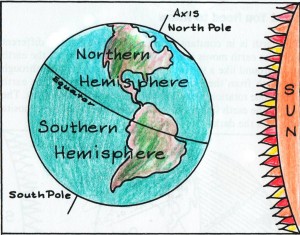Question:
When is the longest day of daylight each year in the Northern Hemisphere?
Facts:
1. The axis of the Earth (imaginary line running through Earth from top to bottom) is tilted in relation to the Sun.
2. The Earth is divided into sections by latitude lines, which circle Earth from east to west.
3. The equator is the latitude line around the center of Earth, half way between the north pole and south pole (these poles are the point where the axis exits).
4. The area above the equator is called the Northern Hemisphere. The area below the eqautor is called the Southern Hemisphere.
4. Tropic of Cancer is the latitude line 23 1/2 degrees north of the equator. Tropic of Capricorn is the latitude line 23 1/2 degrees north of the equator.
5. Earth makes 1 revolution (1 orbit) about the Sun each year.
6. Around June 21, the north end of Earth’s axis is pointing toward the Sun. The south end is pointing away from the Sun. This day is called the summer solstice in the Northern Hemisphere and the winter solstice in the Southern Hemisphere.
7. On the summer solstice in the Northern Hemisphere, sunlight hitting the Tropic of Cancer is perpendicular to the earth’s surface.
ANSWER: The longest day of daylight each year in the Northern Hemisphere is AROUND JUNE 21. In 2009, summer solstice occurs at 1:45 am EDT (Eastern Daylight Time).
For more information about seasons, see Janice VanCleave’s Science Around the World.
